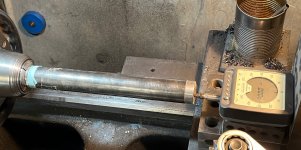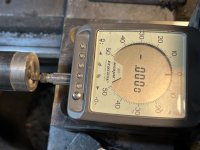dgfoster
Diamond
- Joined
- Jun 14, 2008
- Location
- Bellingham, WA
I am going to violate a double-posting "rule" of internet etiquette as I think this topic is worthy of a more general discussion. My reasoning is that this seemingly generally useful bit of information is buried in a relatively obscure and barely related thread and will not be seen by many.
For as long as folks have been interested in metrology/precision scraping there has been discussion in general terms of the thermal expansion of steel or iron as a result of handling it. But, I can not recall any actual linear measurements of the effect of handling having been been posted on this forum. I can recall plenty of general reports of straight edges, and machine parts distorting and in some cases distortion measured. But actually measuring linear distortion due to handling has seldom (probably has occured) if ever been written down.
In another current thread (Original Post) the question was raised concerning of the degree of distortion one might expect due to bare-hand contact with an iron strut. Since the linear coefficient of thermal expansion of steel is nearly identical to iron, it is practical to use an iron bar to model the behavior of cast iron in this respect.
So, I thought about how to go about making a simple measurement and recording the effect. (This was just one measureemnt under one set of conditions on one bar of circular cross section. More measurements under various conditions with bars of varying cross sectional shape and dimension would certainly be interesting, but a bit tedious.) In a chat with Forrest, I brought up the measurement idea and he quickly suggested a method simpler and more rigid than what I was originally considering. So, credit to him.
I did the test with a 1.25dia by 10" long steel bar that was at thermal equilibrium with the 58 degree F environment of my shop. I simply chucked it up in the bar in the headstock of my EE and placed 2-4-6 and 1-2-3 blocks on the saddle to align my Federal gage with the free end of the bar. I used the tailstock to "block in" the gage. I zeroed the gage and then with my bard hand firmly gripped the bar in its mid- section and kept an eye on the bar. I was surprised to see that the gage didn't flicker up a tenth for 100 seconds. Then I took my hand off and within a few seconds it cooled enough to read .0000" I took the rapid return to ".0000" not to mean that the bar had suddenly returned to its pre-contact length, but rather that the gage had tripped just as the length excursion made the last few hundred thousandths change to .0001" and then again read .0000 as soon as the excursion slipped a few hundred thousnadths less than .0001.
How much net distortion of a casting or weldment surface might occur would clearly depend on how much such a change might be amplified (or minimized) by the geometry of the part in question. A simple braced angle plate tends not to amplifiy the effect, but a long- bowed classic camelback would tend to exaggerate distortion much like a bimetal thermostat distorts disproportionately in response to small temperature changes as the two parallel sheets of metal struggle to accomodate a slight change in the length of one of them.
So, by posting this information I am in no way sugesting that careless handling of reference equipment is OK. Virtually everyone knows the real-world trouble cased by parts are equipment distortion due to a lack of thermal equilibrium. I did find it interesting and potentially informative to make the measurement, however.
Here is the setup used.

Denis

Comments welcome.
Denis
For as long as folks have been interested in metrology/precision scraping there has been discussion in general terms of the thermal expansion of steel or iron as a result of handling it. But, I can not recall any actual linear measurements of the effect of handling having been been posted on this forum. I can recall plenty of general reports of straight edges, and machine parts distorting and in some cases distortion measured. But actually measuring linear distortion due to handling has seldom (probably has occured) if ever been written down.
In another current thread (Original Post) the question was raised concerning of the degree of distortion one might expect due to bare-hand contact with an iron strut. Since the linear coefficient of thermal expansion of steel is nearly identical to iron, it is practical to use an iron bar to model the behavior of cast iron in this respect.
So, I thought about how to go about making a simple measurement and recording the effect. (This was just one measureemnt under one set of conditions on one bar of circular cross section. More measurements under various conditions with bars of varying cross sectional shape and dimension would certainly be interesting, but a bit tedious.) In a chat with Forrest, I brought up the measurement idea and he quickly suggested a method simpler and more rigid than what I was originally considering. So, credit to him.
I did the test with a 1.25dia by 10" long steel bar that was at thermal equilibrium with the 58 degree F environment of my shop. I simply chucked it up in the bar in the headstock of my EE and placed 2-4-6 and 1-2-3 blocks on the saddle to align my Federal gage with the free end of the bar. I used the tailstock to "block in" the gage. I zeroed the gage and then with my bard hand firmly gripped the bar in its mid- section and kept an eye on the bar. I was surprised to see that the gage didn't flicker up a tenth for 100 seconds. Then I took my hand off and within a few seconds it cooled enough to read .0000" I took the rapid return to ".0000" not to mean that the bar had suddenly returned to its pre-contact length, but rather that the gage had tripped just as the length excursion made the last few hundred thousandths change to .0001" and then again read .0000 as soon as the excursion slipped a few hundred thousnadths less than .0001.
How much net distortion of a casting or weldment surface might occur would clearly depend on how much such a change might be amplified (or minimized) by the geometry of the part in question. A simple braced angle plate tends not to amplifiy the effect, but a long- bowed classic camelback would tend to exaggerate distortion much like a bimetal thermostat distorts disproportionately in response to small temperature changes as the two parallel sheets of metal struggle to accomodate a slight change in the length of one of them.
So, by posting this information I am in no way sugesting that careless handling of reference equipment is OK. Virtually everyone knows the real-world trouble cased by parts are equipment distortion due to a lack of thermal equilibrium. I did find it interesting and potentially informative to make the measurement, however.
Here is the setup used.

Denis


Comments welcome.
Denis
Last edited:

